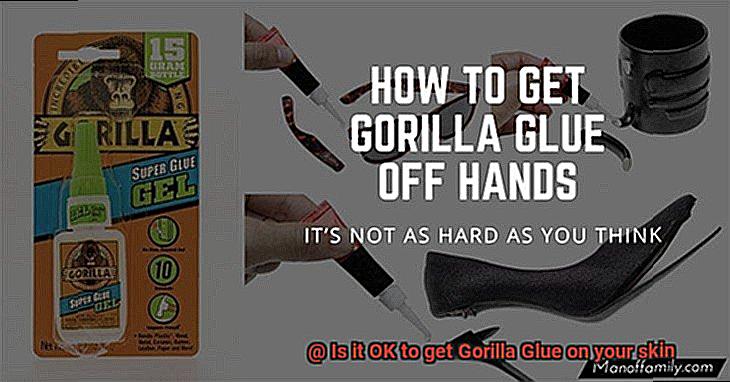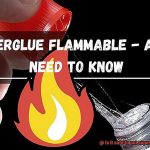Have you ever found yourself in a sticky situation after accidentally getting Gorilla Glue on your skin? Don’t worry; you’re not alone. With its unmatched strength and durability, it’s no wonder why Gorilla Glue has become a household name for fixing almost anything. But what happens when this adhesive comes in contact with your skin? Is it safe, or should you be concerned?
Let’s face it; accidents happen, and getting Gorilla Glue on your skin is one of them. However, before you start panicking, let’s debunk some of the myths surrounding this issue. Gorilla Glue is a polyurethane adhesive that works by expanding and hardening to form an unbreakable bond. While this may sound intimidating, getting it on your skin isn’t necessarily dangerous.
In this article, we’ll explore the effects of Gorilla Glue on your skin and offer useful tips and tricks for removing it without causing any harm. So whether you’re a DIY enthusiast or someone who’s just curious about the potential risks of using Gorilla Glue, read on. We’ve got all the information you need to answer the question: “Is it OK to get Gorilla Glue on your skin?”
What is Gorilla Glue?
Contents
Gorilla Glue is a revolutionary adhesive that has been taking the DIY world by storm since its introduction in 199This polyurethane-based adhesive is known for its incredible bonding strength and versatility, making it a go-to for a wide range of applications.
What sets Gorilla Glue apart from other adhesives is its ability to bond to almost any surface, including wood, metal, ceramic, stone, and even plastic. Whether you’re working on a woodworking project or fixing your car, Gorilla Glue can hold it all together.
Not only is Gorilla Glue versatile, but it’s also waterproof and weather-resistant, making it perfect for outdoor projects or areas where moisture is present. Plus, once it dries, it can be sanded or painted over to match the surrounding surface.
However, with great power comes great responsibility. It’s important to take precautions when using Gorilla Glue as it contains isocyanates that can cause skin irritation or even chemical burns. That’s why wearing gloves or protective clothing is essential when handling this powerful adhesive.
If you do accidentally get Gorilla Glue on your skin, don’t panic. Quickly wash the affected area with soap and water to remove as much of the glue as possible. You can also use an acetone-based nail polish remover or rubbing alcohol to help break down the glue, but use caution as these methods can also cause skin irritation.
How Does Gorilla Glue Affect the Skin?
Gorilla Glue is a powerful adhesive that can stick to almost anything, including your skin. But before you get too comfortable using it, know that this adhesive can cause some serious damage to your skin if it comes into contact with it.
The main component of Gorilla Glue is polyurethane, a type of plastic that can bond almost any surface. When it comes into contact with moisture, such as sweat or water on the skin, it starts to foam and expand. This foaming action can make the glue stick to the skin even further, making it incredibly difficult to remove.
If you’re unlucky enough to get Gorilla Glue on your skin, you might experience irritation, chemical burns, and allergic reactions. People who are allergic to polyurethane may experience symptoms such as redness, itching, swelling, and blistering.
So how can you prevent this from happening? First and foremost, always wear gloves and protective clothing when using Gorilla Glue. This will significantly reduce the risk of getting the adhesive on your skin.

But let’s say you do get Gorilla Glue on your skin. What should you do? Act quickly. The longer the glue stays on your skin, the more difficult it will be to remove. Acetone or nail polish remover might help remove the glue from your skin. But before doing so, test a small area first to ensure that the acetone doesn’t cause further irritation.
If you experience any symptoms such as redness or swelling after getting Gorilla Glue on your skin, seek medical attention right away. Don’t take any chances when it comes to your health.
Symptoms of Gorilla Glue on Skin
No one wants to experience the discomfort and pain of getting Gorilla Glue on their skin. This powerful adhesive is notorious for its strong bonding power, making it difficult to remove once dried. The symptoms of Gorilla Glue on skin can vary depending on the amount and length of contact, but they’re never pleasant.

The first symptom of getting Gorilla Glue on skin is a burning or stinging sensation that can be quite intense. This happens when the glue reacts with the moisture in your skin, producing heat. If left untreated, this sensation can escalate to redness and inflammation of the affected area, causing even more discomfort.
But that’s not all. As the glue dries, it can cause tightening and hardening of the skin, which can be downright painful. Imagine feeling like your skin is being suffocated or squeezed tightly – not exactly a pleasant experience. In some cases, it can also lead to blistering or peeling of the skin, especially if applied to sensitive areas such as the face or hands.
However, the worst symptom of getting Gorilla Glue on your skin is undoubtedly chemical burns. This occurs when the glue comes into contact with a large area of skin or is applied repeatedly over time. Chemical burns can cause significant damage to the skin, including tissue death and scarring, and are incredibly painful.
In addition to physical symptoms, getting Gorilla Glue on your skin can also have psychological effects. For people who have a phobia of being stuck or trapped, the fear of not being able to remove the glue from their skin can trigger anxiety or panic attacks.
If you get Gorilla Glue on your skin, it’s essential to take immediate action. Minor symptoms can be treated with warm water and soap, but more severe symptoms may require medical attention. It’s always best to avoid contact with Gorilla Glue altogether and use protective gear such as gloves or goggles when handling it.
Prevention and Safety Tips for Avoiding Gorilla Glue on Skin
Gorilla Glue is a powerful adhesive that can easily stick to your skin and cause harm if not handled properly. To prevent any potential injury, it’s crucial to follow prevention and safety tips when using this adhesive. Here are five sub-sections that explain these tips in detail:
Wear Protective Gear
When working with Gorilla Glue, always wear protective gear such as gloves and long-sleeved clothing. This will help protect your skin from coming into contact with the glue. In addition, it’s important to avoid wearing clothing that can easily absorb glue or get stuck to your skin.
Use a Barrier Cream
Applying a barrier cream like petroleum jelly or a water-based lotion can create a protective layer on your skin. This layer can make it easier to remove the glue if it accidentally gets on your skin. It’s important to note that barrier creams should be applied before handling the adhesive.
Keep the Glue Away from Your Face
Gorilla Glue should never be used near your face, especially around sensitive areas like your eyes and mouth. If the glue accidentally comes into contact with these areas, seek medical attention immediately. It’s best to work in a well-ventilated area with plenty of space to avoid accidents.
Keep the Glue Out of Reach of Children
Gorilla Glue should always be stored in a safe place away from children and pets. Ingesting this adhesive can cause serious harm to their health. It’s important to educate children about the dangers of Gorilla Glue and supervise them when working on projects that involve adhesives.
Read the Instructions Carefully
Before using Gorilla Glue, read the instructions carefully to ensure that you are using it correctly and safely. Follow the recommended safety precautions and use only as directed. This includes using the appropriate amount of glue and allowing it to dry completely before handling the object.
In case of accidental contact with Gorilla Glue, it’s important to act quickly. Avoid pulling the glue off your skin as this can cause damage. Instead, gently dab the affected area with a dry cloth or tissue to remove any excess glue. Then, wash the affected area with warm soapy water for at least 15 minutes. This will help to loosen the glue and make it easier to remove.
If warm soapy water isn’t effective, you can try using acetone or nail polish remover. However, use these solvents sparingly and only as a last resort as they can cause irritation and dryness to your skin if used excessively.
Treatment for Gorilla Glue on Skin
Accidentally getting Gorilla Glue on your skin can be a sticky situation, but fear not. As an expert on this topic, I have some tips to help you safely remove the adhesive without causing harm to your skin.
First things first, do not attempt to pull the glue off your skin as it can result in injury and worsen the situation. Start by washing the affected area with soap and warm water for at least 15 minutes.
This will help loosen the glue, making it easier to remove. If the glue is still stuck, try using a mild solvent such as acetone or rubbing alcohol to break it down. Just be sure to use caution and avoid applying too much pressure.
If the above methods don’t work, don’t worry. You can also gently scrape away the glue using a mild abrasive like sandpaper or a pumice stone. But again, be sure to use caution and avoid applying too much pressure, as this can cause injury to your skin.
However, if none of these methods work, it’s best to seek medical attention. A healthcare professional can use specialized treatments like skin-safe adhesive removers or liquid nitrogen to safely remove the Gorilla Glue from your skin.
Prevention is always better than cure, so next time you’re working with Gorilla Glue, make sure to wear protective gear and use a barrier cream to avoid getting it on your skin in the first place.
When to Seek Medical Attention for Gorilla Glue on Skin
While prevention is key, it’s important to know when to seek medical attention when Gorilla Glue ends up on your skin.
First and foremost, if Gorilla Glue comes into contact with your eyes, mouth, or nose, seek medical attention immediately. These areas are extremely sensitive and any type of glue, including Gorilla Glue, can cause significant harm. Don’t hesitate to call your local emergency services or visit the nearest hospital right away.
Accidentally ingesting Gorilla Glue is another situation where prompt medical attention is crucial. This can lead to blockages in the digestive system and other serious health problems. If you or someone you know ingests Gorilla Glue, call your local poison control center or visit the nearest hospital without delay.
If you have Gorilla Glue on your skin and experience pain or discomfort, seek medical attention as soon as possible. The glue can cause irritation and even chemical burns if left on the skin for too long. A medical professional can assess the damage and recommend the appropriate treatment.
In summary, knowing when to seek medical attention for Gorilla Glue on skin could mean the difference between a minor accident and a major health issue. If the glue comes into contact with sensitive areas like the eyes, mouth or nose, is accidentally ingested or causes pain or discomfort on the skin, don’t take any chances – seek medical attention immediately.
Conclusion
To wrap it up, getting Gorilla Glue on your skin can be a sticky situation. This versatile adhesive is known for its unmatched strength, but it’s important to take precautions when using it. Protective gear such as gloves and long-sleeved clothing, barrier creams, and careful instruction reading are essential in preventing accidents.
However, if you do find yourself with Gorilla Glue on your skin, don’t hit the panic button just yet. Act fast by washing the affected area with warm soapy water or using a mild solvent like acetone or rubbing alcohol. It’s crucial not to pull off the glue as this can cause damage. If these methods fail, seek medical attention from a healthcare professional who can safely remove the glue.
Remember that prevention is key in avoiding any major health issues. Seek immediate medical attention if the glue comes into contact with sensitive areas like the eyes, mouth or nose, causes pain or discomfort on the skin, or is accidentally ingested.
In summary, while Gorilla Glue may be a powerful adhesive that sticks to almost anything including your skin, following safety tips and taking precautions will keep you out of harm’s way.






